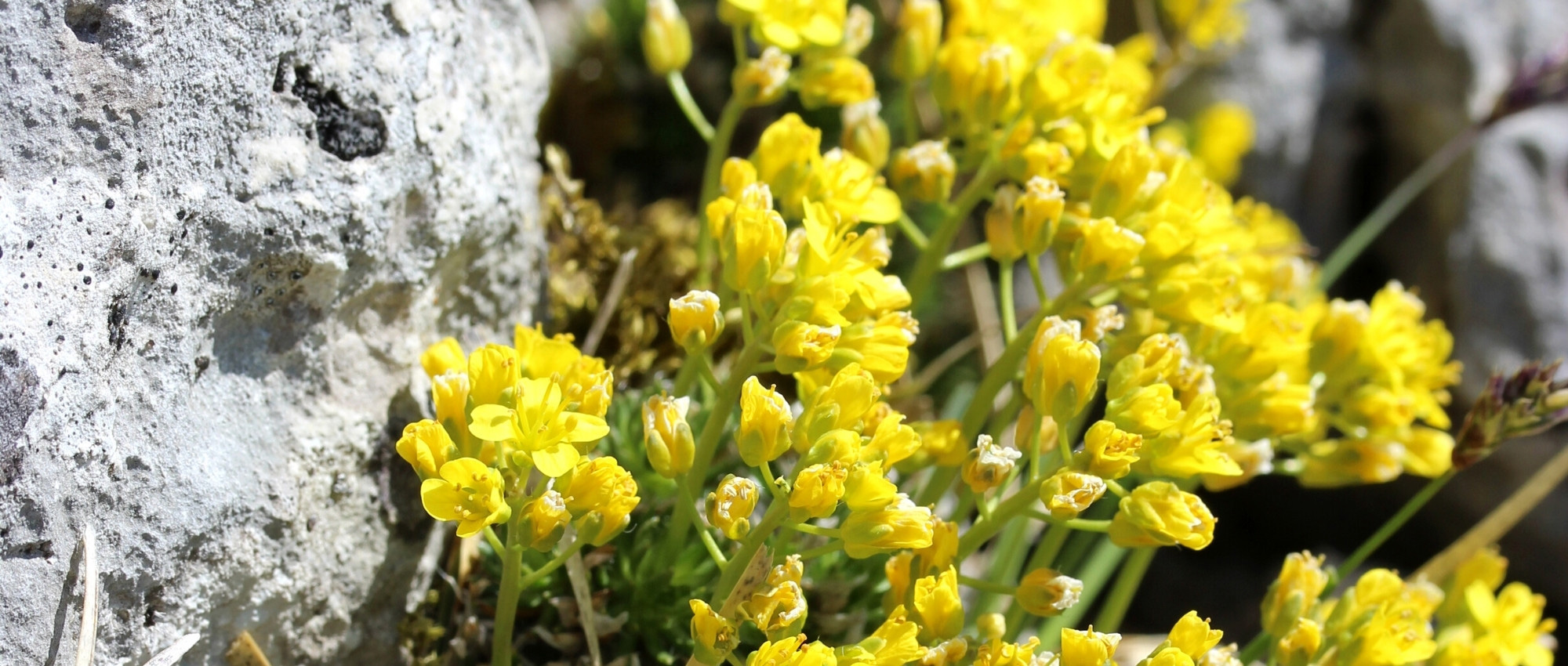
Draba: planting, growing, and care
Contents
Draba in a nutshell
- Draba are delightful little rock garden plants that do not exceed 15 cm in height.
- They form charming rosettes of elongated, evergreen leaves.
- In spring, their yellow or white flowers are appreciated, gathered in small bouquets.
- They thrive in full sun in perfectly drained, stony or sandy soil.
- Draba aizoides offers a stunning bright yellow flowering display!
A word from our expert
Draba or drabas are small spreading plants that produce bright yellow or white flowers in spring. Still relatively unknown and rarely cultivated, they are not common in gardens. However, there are some stunning species, such as Draba aizoides, also known as false aïzon draba. This charming perennial forms small rosettes of elongated, evergreen leaves and bears bright yellow flowers with four petals, clustered together, from April to June. It is a small plant, measuring between 10 and 15 cm in height when in bloom. There are also very beautiful species with white flowers, such as Draba sakuraii.
Draba are ideal plants to incorporate into a sunny rockery. They require perfectly drained, sandy or stony soil, as they are sensitive to stagnant moisture. Aside from this precaution, Draba are easy to grow. They are quite hardy, tolerating temperatures around –15 °C, and even lower. They pair well with other spreading rockery plants, such as houseleeks, sedums, Arenaria montana, aubrietas, iberis, Alyssum… Discover all our tips for successfully growing Draba in the garden!
Botany
Botanical data
- Latin name Draba sp.
- Family Brassicaceae
- Common name Drave
- Flowering spring, between March-April and June
- Height up to 10-15 cm
- Sun exposure full sun
- Soil type draining, stony
- Hardiness -15 to -20 °C
Draba, or Draves, comprises over 400 species of plants that are generally perennial, but occasionally biennial or annual. These are small herbaceous plants, typically with a spreading habit. Generally, they are quite inconspicuous, with tiny white or yellow flowers, making them easy to overlook in nature (like Draba verna, a small annual that grows spontaneously in France). In the wild, Draba thrive in temperate and arctic regions of the Northern Hemisphere, as well as in South America in the Andes. They are found mainly at altitude, in scree and rocky areas. Several species grow wild in France (the most common being Draba aizoides, Draba muralis, and Draba verna). Draba aizoides is found on limestone rocks and cliffs in the mountainous regions of Europe, up to 3,500 metres in altitude.
Draba belongs to the Brassicaceae family, formerly known as Cruciferae. This is the family of cabbage, turnip, rapeseed, mustard, radish, etc. This family is characterised by flowers with four free petals, shaped like a cross, often yellow or white, and fruits in siliques. In addition to Draba, a few other species are cultivated as ornamental plants: wallflowers, aubrietas, iberis, Alyssum, Hesperis matronalis…
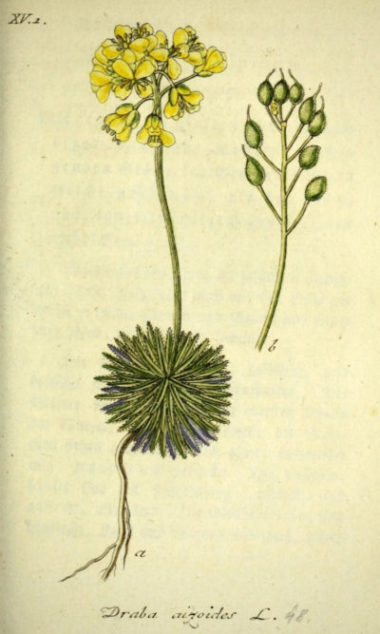
Draba aizoides: botanical plate
Etymologically, the name Draba comes from the Greek drabé, meaning “bitter”, due to the bitter juice that some species contain in their tissues.
Draba should not be confused with Lepidium draba, the peppergrass drave, another plant in the Brassicaceae family.
Since it naturally grows in mountainous and rather cold regions (arctic and northern areas), Draba is a very hardy plant. It easily withstands temperatures between -15 and -20 °C, and even lower, depending on the species.
All Draba are small plants: they measure between 5 and 20 cm in height. They generally have a spreading or small cushion habit and gradually spread over time. Draba aizoides reaches between 10 and 15 cm in height when in flower.
Draba bryoides is surprising, as it truly forms a small rounded cushion that resembles moss, made up of numerous tiny leaves, imbricate against each other. This particular shape allows it to withstand the extreme conditions of the mountain (cold, wind, desiccation)!
In general, the leaves of Draba are small, often ovate, lanceolate, or linear, and green in colour. They are entire, not divided. They are numerous and densely arranged in a rosette. Some species have pubescent leaves, covered with small hairs.
The Draba aizoides forms rosettes of elongated leaves. They are lanceolate, narrow, and stiff. Densely arranged, they measure 0.2 to 2 cm long and are equipped with stiff, white bristles along the edge of the lamina.

The foliage of Draba aizoides: overall view (photo Ghislain118) and detail of the leaves / the foliage of Draba verna (photo AnRo0002)
The leaves of Draba aizoides are evergreen: it retains its foliage in winter. Other Draba species are either evergreen or semi-evergreen.
Draba are spring-flowering plants, between April and June. Their flowers can be bright yellow, as in Draba aizoides, or white, as in Draba verna. Arranged in small terminal clusters, they consist of four free petals arranged in a cross, more or less notched at the top, and four sepals. The flowers bear six stamens (four long and two shorter) at the centre: these are the male sexual organs that carry the pollen. This will be deposited on the pistil (female sexual organ) to produce seeds.

The flowers of Draba aizoides (photos: Björn S. / febs), and Draba sakuraii (photo Ghislain118)
Depending on the regions and climate, the Draba aizoides flowers between March-April and June. It then produces upright, unbranched stems from its rosettes, not exceeding 15 cm in height. They bear at their tips a cluster of bright yellow flowers, consisting of petals about 0.5 cm long. The flowers are relatively large compared to other species.
If you prefer white flowers, opt for Draba sakuraii, a rare plant native to the mountains of Japan, which also has beautiful ornamental qualities. It bears flowers in May-June composed of four broad petals of pure white.
Draba verna, or Spring Drave, is a small annual plant that grows wild in France. It has inconspicuous flowers made up of four very finely notched petals, giving the impression that the flower has eight petals.
The fruit of Draba is an oval or elliptical silicula, ending in a long point (persistent style). When mature, it opens into two valves to release the seeds.

The silicula fruits of Draba aizoides (photo Jason Grant) / those of Draba verna (photo Danny S.), with a detail of the seeds contained inside (photo Rasbak)
Read also
Alpine perennial plantsThe main varieties
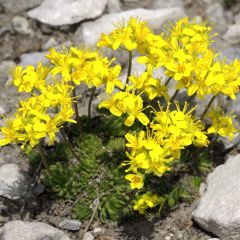
Draba aizoides
- Flowering time May to July
- Height at maturity 8 cm
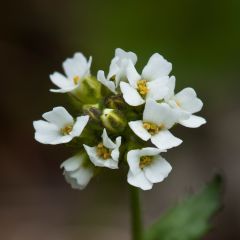
Draba sakuraii
- Flowering time April, May
- Height at maturity 10 cm
Discover other Draba
View all →Available in 1 sizes
Available in 1 sizes
Planting
Where to plant?
In the wild, Draba grows in mountainous, rocky environments, in scree or on cliffs, so it thrives in a mineral medium and is perfect for rock gardens. It requires perfectly drained, sandy or gravelly soil, as it is sensitive to stagnant moisture. It can easily tolerate dry and poor soils. Similarly, it needs excellent light and will flourish if you place it in full sun. Draba aizoides prefers calcareous soils.
As it does not appreciate having water directly on its foliage, if possible, consider placing it at the base of a large stone that would overshadow it and provide some shelter from the rain.
Since it is a small, rather discreet plant, do not hesitate to plant several close together in a rockery. This will create a more beautiful effect, and they will be more noticeable without having to wait years for the plants to fill out.
Draba can also be grown in pots, in a draining substrate. This will also make it easier to protect it from winter moisture by placing it in a cold greenhouse or under an eave.
Feel free to consult our advice sheet for creating a rockery!
When to plant?
We recommend planting Draba in spring, around April, or in autumn (October).
How to plant?
For planting in the ground:
- Find a suitable location, for example, between stones in a rockery.
- Dig a planting hole.
- Add potting soil mixed with a bit of gravel or coarse sand to the hole for drainage.
- Remove the Draba from its pot and plant it.
- Fill the hole by adding some substrate all around to secure it, but without burying the foliage.
- Lightly compact the soil.
- Water, avoiding wetting the leaves.
For planting in a pot:
- Take a pot with drainage holes at the bottom.
- Place a small layer of clay balls at the bottom of the pot.
- Fill the pot with a mixture of soil, leaf mould, and coarse sand.
- Plant the Draba.
- Add substrate around it, ensuring not to bury the collar or the basal leaves.
- Place a small layer of gravel on the surface of the substrate around the plant. This will insulate it from moisture and reduce the risk of rot.
- Water, avoiding wetting the leaves.
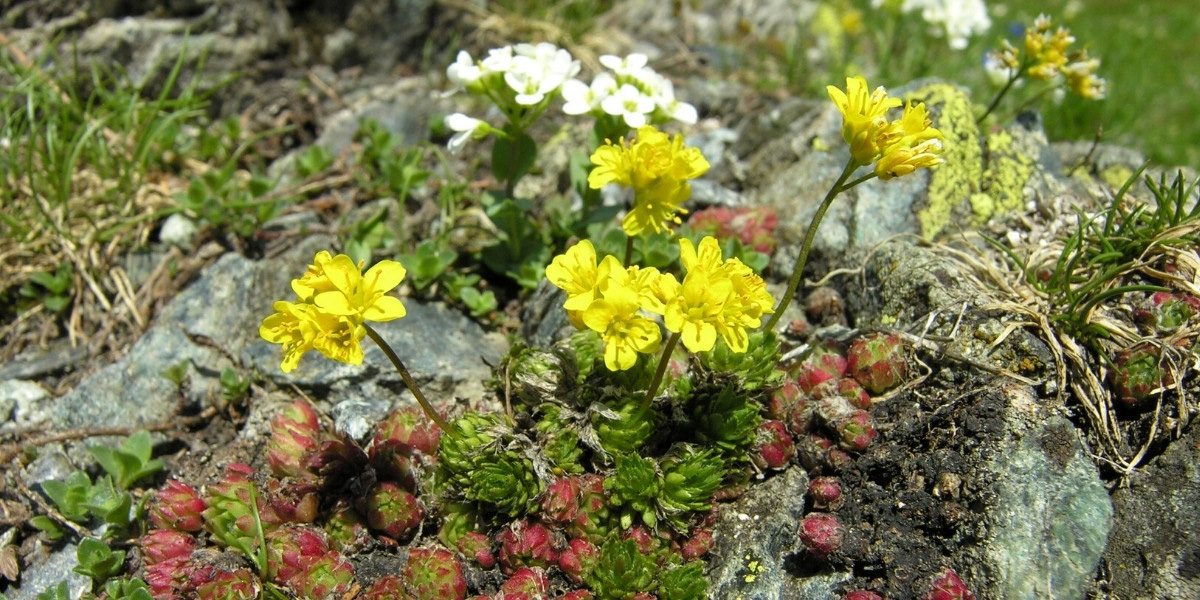
Draba aizoides (photo Andrea Moro)
Entretien
We recommend watering the Draba in the weeks following planting. Direct the water around it, but avoid wetting its leaves, as stagnant water on the rosettes could cause them to rot. Since it is a rock garden plant, suited to dry and poor soils, it will not require further watering. It also does not need fertiliser. You can simply provide a little water in case of prolonged drought.
The Draba is easy to grow, but it is sensitive to excess moisture. It is best to protect it from heavy winter rains, for example by placing a glass or clear plastic sheet above it. You can remove this sheet in spring.
As it is a small plant, if you see weeds growing around it, do not hesitate to remove them regularly to prevent it from being smothered. Similarly, we recommend placing a small layer of gravel around the Draba, as this will limit the growth of adventive plants, in addition to isolating it from moisture.
The Draba is not very susceptible to diseases and pests. However, when grown in a greenhouse, it can be attacked by aphids and red spider mites.
Multiplication
Sowing
Draba is primarily propagated by sowing.
- Seeds must undergo vernalisation to germinate: place them in the refrigerator for about a month. This step mimics winter and breaks the dormancy of the seeds.
- Take a pot or seed tray.
- Fill it with special sowing compost, then lightly firm it down and level the surface.
- Place the seeds on the surface.
- Cover them with a very fine layer of substrate.
- Water gently.
- Place the pot or tray in a bright location, out of direct sunlight. Ideally, the temperature should be between 15 and 20 °C.
Draba generally takes between 1 and 3 months to germinate.
Division of Clumps
If you have a Draba plant that is several years old and has spread, it is possible to take peripheral rosettes and replant them to propagate. The best time to do this is in spring.
Association
Draba aizoides is a mountain plant that will fit perfectly in an alpine rockery. Choose a raised spot in full sun, or create a mound. Mix gravel, stones, or sand into the soil to improve drainage, and place some large stones to retain the soil. Ensure they are well secured so they don’t move later. All that’s left is to plant the Draba aizoides with other alpine perennials in the gaps between the stones. For example, integrate Edelweiss, the emblematic plant of the Alps! Also consider Arenaria montana, Saxifraga arendsii, aubrietes, Alyssum… These plants form lovely little rounded cushions that will beautifully dress the space between the stones. Enjoy the charming small palmate leaves of the Alpine Lady’s Mantle, and the rosette foliage of houseleeks. Also discover the beautiful star-shaped, orange-pink flowers of Lewisia cotyledon.
If you would like more tips on creating a rockery, feel free to check our guide “Creating a Rockery: Our Tips for Success”.
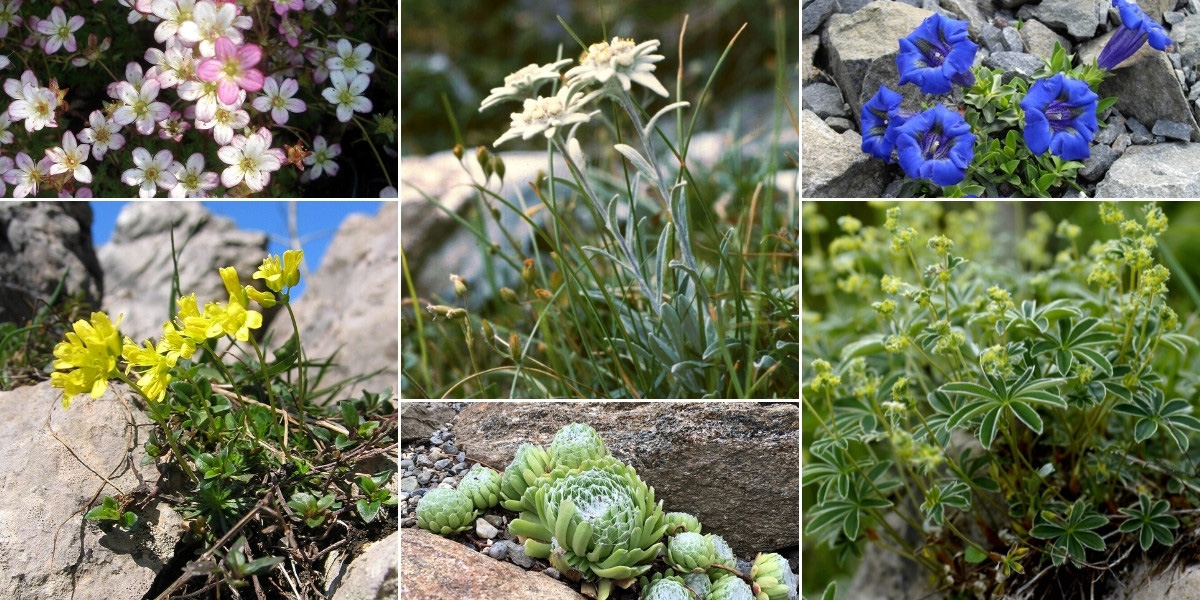
Draba aizoides integrates easily into a rockery, for example with other alpine plants. Saxifraga arendsii ‘Pixie’, Edelweiss Leontopodium alpinum (photo Franz Xaver), Gentiana acaulis (photo Ghislain118), Draba aizoides (photo Tigerente), Sempervivum arachnoideum (photo Kristine Paulus), Alchemilla alpina (photo Udo Schmidt)
You can also plant Draba on a stone wall, alongside wall bellflower, sedums, houseleeks, globularias, Erigeron karvinskianus, Iberis… Not to mention the generous colourful flowering of aubrietes. These plants require very little substrate and will easily slip their roots into the crevices between the stones. For more ideas, discover our selection of perennial plants to enhance a low garden wall.
Useful resources
- Discover our range of Draba
- Our advice sheet: “Creating a rockery: our tips for success”
- To pair with Draba, feel free to check our entire range of perennial plants for rockeries
- Subscribe!
- Contents

































Comments